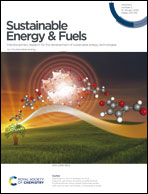Ultrahighly nitrogen-doped hollow carbon spheres with hierarchical pores for highly reversible lithium–sulfur batteries†
Abstract
Carbon materials are widely used as cathode host materials for lithium–sulfur batteries due to their high specific surface area and high conductivity. Rational structural design can improve the sulfur storage capacity of carbon materials, and appropriate heteroatom doping can enhance the adsorption capacity for lithium polysulfides, thus improving the cycling stability of lithium–sulfur batteries. Herein, we synthesized nitrogen doped porous carbon spheres (NHCSs) with high nitrogen content as cathode host materials for lithium–sulfur batteries, and prepared porous carbon spheres with different nitrogen contents by heat treatment. In comparison, the porous carbon spheres with the highest nitrogen content possess the best polysulfide adsorption capacity and electrochemical activity, leading to a high initial capacity of 806.54 mA h g−1 at 2C and excellent capacity retention rate of 85.71% after 500 cycles. The high electrochemical reversibility and reaction mechanism of carbon spheres with high nitrogen content were confirmed by in situ Raman and in situ XRD. Moreover, NHCS-1/S still exhibits a high areal capacity of 4.11 mA h cm−2 even with a sulfur loading of 4 mg cm−2. This study provides a new strategy and direction for the design of carbon materials as cathode host materials for lithium–sulfur batteries.



 Please wait while we load your content...
Please wait while we load your content...